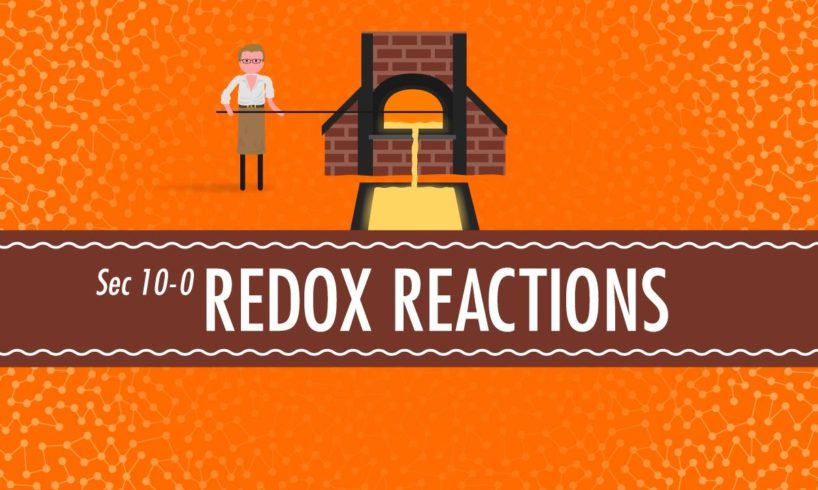
All the magic that we know is in the transfer of electrons. Reduction (gaining electrons) and oxidation (the loss of electrons) combine to form Redox chemistry, which contains the majority of chemical reactions. As electrons jump from atom to atom, they carry energy with them, and that transfer of energy is what makes all life on earth possible.
Oxidation 1:42
Reduction 1:03
Oxidation Numbers 3:29
Redox Reactions 5:59
Oxidation Reactions 6:28
Balancing Oxidation Reactions 7:18
Thank you to the following chemistry teachers for their assistance:
James Sarbinoff
Rachel Wentz
Edi González
Lucas Moore
Chris Conley
Addie Clark
Julia Rosinski
Special Thanks to Matt Young at the University of Montana (Geosciences Department, Environmental Biogeochemistry Lab) who helped with the chemical demonstrations.
Pssst… we made flashcards to help you review the content in this episode! Find them on the free Crash Course App!
Download it here for Apple Devices: https://apple.co/3d4eyZo
Download it here for Android Devices: https://bit.ly/2SrDulJ
Crash Course is on Patreon! You can support us directly by signing up at http://www.patreon.com/crashcourse
Want to find Crash Course elsewhere on the internet?
Facebook – http://www.facebook.com/YouTubeCrashCourse
Twitter – http://www.twitter.com/TheCrashCourse
Instagram – https://www.instagram.com/thecrashcourse/
CC Kids: http://www.youtube.com/crashcoursekids
source







Pssst… we made flashcards to help you review the content in this episode! Find them on the free Crash Course App!
Download it here for Apple Devices: https://apple.co/3d4eyZo
Download it here for Android Devices: https://bit.ly/2SrDulJ
LEO said GER
WE are learning about reduction and oxidation right now like in eight grade
intro aged like milk
It made my Canadian soul unreasonably happy to see a loonie being used as your example of a "dollar".
"AnD tHoSe ArE aLl ThE rUlEs" sir i need to remember all of these by tomorrow!! }:(
Who here 2020 like if agree
Here’s a good way of remembering why reduction is called “reduction”. Electrons are negatively charged, so a “gain” in electron caused a “reduction” in charge. Like if Sodium cation (+1) charge recieves an electron, it become Na(0 charge), so it’s charge reduces
I hate this guy
how would you know how many electrons to add, like for the n^2 example why is it 3 electrons
Halogens have a very high ionization energy (not low, as written on the periodic table at 4:54). Only the noble gases have higher ionization energies. Ionization energy is the amount of energy required to remove an electron from an atom. So, it is very difficult to remove electrons from the halogens, and even more so from the noble gases. In contrast, the alkalis have very low ionization energies. Great video! Thank you!
if atoms in their elemental form have an oxidation number of zero, then how come Ag at the end of the redox reaction has oxidation number of +1 if he says it is elemental silver? someone pls shed light v confused
Maybe change Reduction to Chom Choms?
Can I ask whether anyone here knows about the methods of doing the experiment in the video (Silver diamine with the aldehyde)?
Get that deflated orange buffoon off my screen!
Money is the root of all evil ~
you can also think of reduction as the reduction of CHARGE that occurs when an atom gains electrons. When an atom starts with a charge of 0 but gains an electron, its overall charge is REDUCED to -1
I learnt from this video is Trump is polyamorous and is married to an Alien 🤣😂
Oxygen
Is
Less
Reduced
Is
Gain
OIL RIG.
Yoooo the intro had me laughing so hard
Is that Trump? Please tell me that's not Trump. I don't want this wonderful video to be prescient in any way. That'd make me cry 😭
aye whose in quarantine rn
9:02 Hey aldehyde is not a neutral compound on itself…..It need a hydrogen or an alkyl or an aryl to become neutral….So Carbon should have an oxidation of either +2 or -4…Same for the carboxylic acid….Am I right?
It's very funny that you have Trump in these videos from 2013.
I like the way they used Donald Trump reference again. He is rich anyways.